James Nutter was born on 5 February 1845 at Howgill, Rimington and baptised on 27 March 1845 at Martin Top Chapel. In the 1851 census he is recorded as ‘Jas’ , 6 years old and living at Howgill with his father, James, his mother Jane and 5 siblings. When he was 10 the family moved to Barnoldswick. He eventually became very successful in the textile industry. The mill engine and related buildings, all that remain of the mill that James Nutter instigated but never saw completed, are now in the care of a charity, Bancroft Mill Engine Museum. To visit their website click here


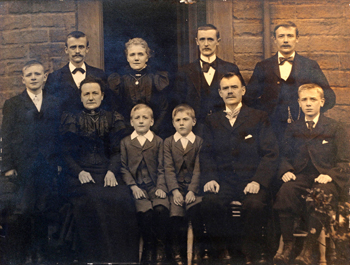
The pictures are of: James and his wife Mary Jane (presented to James and his wife by the Liberal Club). The family photograph is of James, Mary Jane and their children. I think, looking at the ages of the children, that it was taken in the mid 1890s. The names and birth order of all the children are known, but it is difficult to know looking at the back row, the age order of the brothers. Mr Nixon, treasurer of the museum (2022), is fairly sure though that the young man seated on the right of the photo (sitting on his father's left) is Wilfrid Nutter who managed the Mill from 1920, pretty much up until his death in 1958. At that point the Mill was sold and the family were no longer involved. The new owners ran it until closure in Dec 1978.

Bancroft Mill before it was mostly demolished)
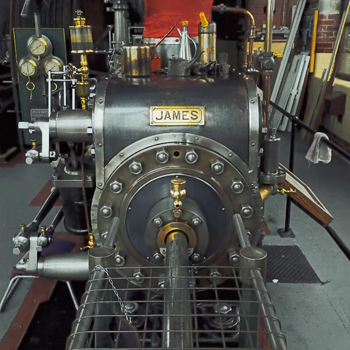

These pictures of the high and low pressure cylinders of the mill engine, named after james and his wife, were taken by Tony Nixon, treasurer of the museum.


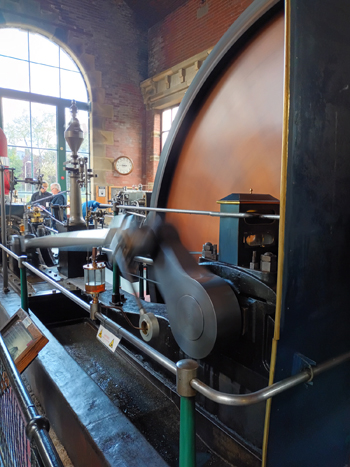
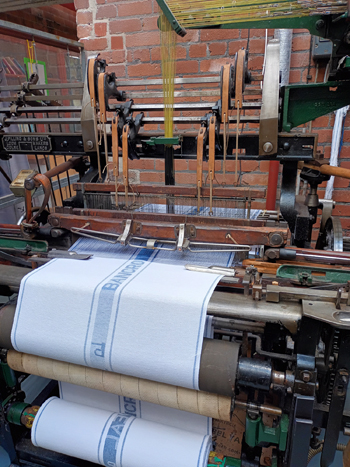
These pictures of the engine and the loom, weaving tea towels, were taken by lesley Marklew.
The following biography is taken from the Bancroft Mill's Summer 2019 Newsletter. .
‘’ James Nutter was born at Howgill, near Rimington, Lancashire, in 1845. He received no formal education, and at the age of eight years, began work at a local shoddy mill for 1/-d (5p) a week. Shoddy mills ripped up and shredded waste material, either by hand or with a machine called a “devil”, and mixed it with wool, to produce low quality cloth. When he was ten years old, James moved with his family to Barnoldswick, where they resided at Townhead.(Note 1) There he began his education at Old Tom Jolly’s Seminary, at a cost of 1d per week. Presumably he learnt to read and write at that establishment, although he later said that he doubted whether Old Jolly could read himself! James also worked at Billy Bracewell’s mill as a “throstle doffer”. Throstles were the name given to the water frames used in spinning yarn, as they sounded like a throstle, or thrush, when in action. Mr Bracewell, also known locally as Old Billycock, because of the hat he always wore, owned Butts Mill and Wellhouse Mill as well as a colliery and the local cornmill. At eighteen years of age, James was not happy with his prospects, and moved to Edenfield, near Ramsbottom, where he had some relatives. He obtained employment with the firm of Messrs. Porrit and Austin as a wool spinner. Soon he was earning 30/- (£1.50) and more a week, which was a large sum in those days. He was able to send money to his parents, who were not having an easy time. After a while, however, the firm’s partnership was dissolved, and James returned home, although with the promise of more work at Edenfield if the firm was reinstated. Not long after that the firm did start up again, and James returned to his old job, staying there for a few years. It was during this period that he met his wife, Mary Jane Chadwick. They were both twenty-three years of age (1868). After they were married, they returned to Barnoldswick. They lived at Stopes House, about 100 yards down the road from the Mill - it’s still there. James must have become dissatisfied with the textile industry at this time, because he began, together with his father, to sell books from door to door. They sold mainly bibles and obtained them from Blackie’s the publishers of Edinburgh. They were quite successful and before long James had saved sufficient money to start a textile venture of his own. In 1876 he began with 56 looms at Coates Mill, off the Thornton Road, between the Leeds and Liverpool canal and the Stock Beck. It was common in those days to rent looms and premises, and also the power of a steam engine. This was known as “room and power”. At that time there were only three other weaving sheds in Barnoldswick; later there would be thirteen. James remained at Coates for about four years, then entering into partnership with his brother-inlaw, Slater Edmondson. He then moved to Clough Mill, near the centre of the village, off Walmsgate. This had originally started as an 18th century water mill, preparing warp and weft for putting out to hand-loom weavers. In 1846, it became the first cotton factory in the town, with a power-loom shed built onto the old building, driven by a steam beam engine. Later, the partnership was dissolved, and James moved to Long Ing shed, beside the canal to the east of the town, where he ran 400 looms. He remained there for five years. His next move, around 1890, was to Calf Hall shed, near Wapping in Barlick, with 414 looms, where he remained until the opening of Bankfield shed. This shed was later taken over by Rolls Royce. There he ran 900 looms and would obviously have employed a good number of staff. About 1909 the firm became a private limited company entitled James Nutter & Sons Ltd. During 1914, plans were in hand to build a completely new mill for the firm, but the Great War intervened, and the work was put on hold for a few years. From such humble beginnings, James Nutter progressed to become an eminent figure in the area. He was elected to the first Local Board, and remained on the Urban District Council until poor health forced him to retire from public service. James also devoted over 50 years to the Independent Methodist Church. During the later years of his life, he travelled extensively, visiting Palestine, Egypt on six occasions and America. He died at Southport on 14th February 1914, survived by his wife, seven sons, a daughter and 23 grandchildren. So, James Nutter never saw his new mill. The building work continued after the War, the firm being run by his sons. On 13th March 1920, the mill engine was ceremonially started by his daughter, Eliza Jane Slater, and Bancroft Mill became the thirteenth and last mill to be built in Barnoldswick. At the time it embodied the latest in modern technology and it ran for the next 58 years. The two cylinders of the preserved engine are still named in recognition of James and his wife.’’
Note 1 - It is a reasonable assumtion that James was working at Howgill textile mill. It is belived that it ceased to operate in 1858 so that is probably why the family moved to Barnoldswick To find information about Howgill Mill click here


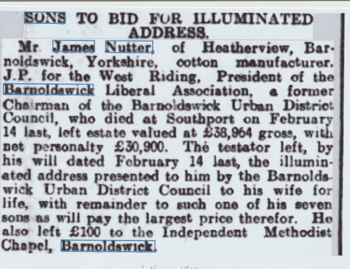
The 1st picture above is of a newspaper article of 19 July 1907 reporting on the company registration of J Nutter and Sons.
The 2nd picture is of a newspaper report of 24 April 1908 when James Nutter attended the opening of Martin Top Chapel burial ground.
The 3rd picture is of a newspaper report of 2 May 1914 with details of his will.His estate was valued at £38964, which is equivalent in 2021 to approximately £4.5million. The will also included an unusual item regarding bidding for an illuminated address.
